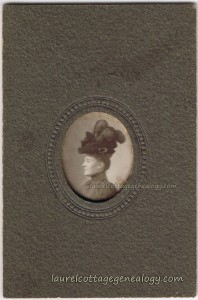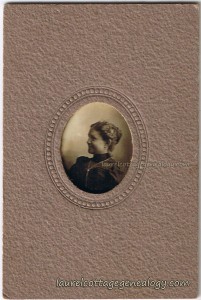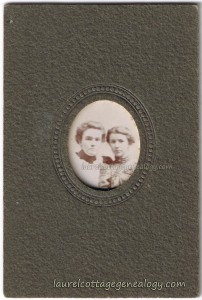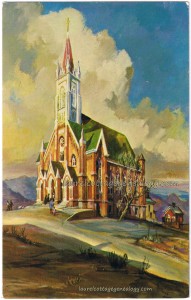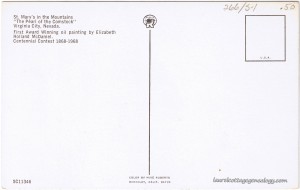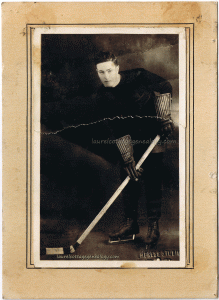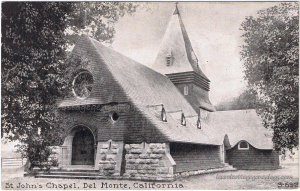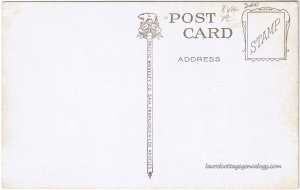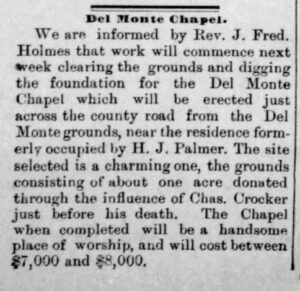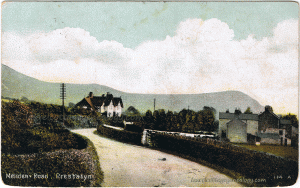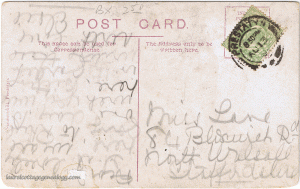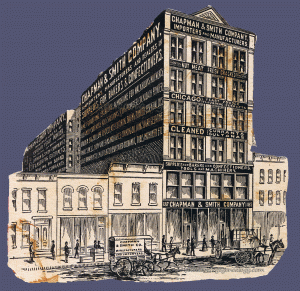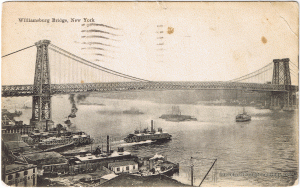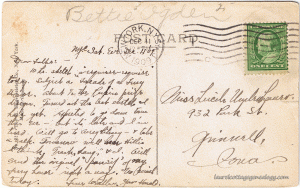According to Michigan death records, Charles A. Millard was born in Connecticut about 1834, and died in Detroit on January 25, 1890 or 1891. There are several entries for the 1890 date, and one entry showing 1891. C. A. Millard was a prominent photographer in Detroit. Page 125 of the 1880 city directory for Detroit shows an advertisement taking up one third of the page for Powelson & Millard, (Successors to B. F. Powelson,) Artistic Photographers. Address 224 and 226 Woodward Ave., Detroit. A price breakdown showing as: Photos in cards from $2.00 – $3.00 per dozen. Cabinets from $5.00 – $8.00 per dozen. Panels from $5.00 – $10.00 per dozen. Life-size portraits in Crayon, India Ink, Oil and Water Colors from $25.00 – $100.00. Negatives preserved.
See Detroit Girl for one example of Charles Millard’s work.
There is an excellent book by John William Leonard with the amazingly long title of: The Industries of Detroit: Historical, Descriptive and Statistical. Her Relations as a Centre of Trade, Manufacturing Establishments and Business Houses. (This book contains some wonderful illustrations for early Detroit buildings, the waterfront, etc.) The author’s preface is dated October 1887. Quoting Leonard, “Mr. Millard is engaged in all kinds of first-class photographic work, making specialties of life-size portraits in crayon, India ink, pastelles, oil and water colors: and commercial work in photographs, albertypes, and photo-lithographs. The excellence attained by him of all departments of his business has secured for his studio a patronage not only from the residents of Detroit, but also from visitors from all parts of the Union and Canada.” Leonard describes the studio as “one of the most elegantly appointed in the country” and the size of the employed workforce as between ten and fifteen “highly skilled artists.” C. A. Millard teamed up with Benjamin F. Powelson and later bought out Powelson, according to Leonard’s entry, “about eight years ago” which would make that about 1879 according to the author’s preface date of 1887. According to Leonard, prior to the Woodward Ave. address, the studio was located on Jefferson Ave. in Detroit, moving to Woodward Ave. “ten years ago” so about 1877. Leonard also described the studio as the oldest in the city at that time.
Prior to the Woodward Ave. address, Detroit city directories show “Powelson & Co.” in 1870 at 5 Monroe Ave. and Campus Martius; B. F. Powelson at 223 Jefferson Ave. in 1875 and 219 Jefferson Ave. in 1892. The “& Co.” in 1870 for Powelson probably didn’t include Millard, as this census shows Scotland born photographer, Thomas Houghton, rooming with the Powelson family.
Family and residence info on C. A. Millard: Charles A. Millard married Sarah Avery and they had two daughters, Lillian and Grace. Grace married Seymour H. Knox on June 11, 1890 in Detroit. (FamilySearch) Seymour Knox’s parents are listed on the marriage record as James H. Knox and Jane McBrier. According to the marriage record Grace was born in Connecticut about 1865 and Seymour was born in New York about 1861. The 1893 Detroit social directory, “The Blue Book” shows Mrs. Sarah Millard, Miss Lillian Millard and Mrs. R. S. Avery. The earlier 1883 Blue Book shows a residence address at 216 Bagg St. for Charles Millard, Mrs. Charles Millard, Miss Lillie Millard and Miss Grace Millard. (The ’83 also has an ad for “Millard. Photographer” showing up on page 6.) The 1880 Ionia, Michigan census shows Charles Millard, wife and daughters. Charles A. Millard shows up under his photographer heading in the Detroit City directories with residence addresses as: rooms at 101 Adams Ave. in 1880, residences of 479 Cass in 1881, 216 Bagg in 1883 and 104 Ledyard in 1884. It looks like the family’s longest residence in Detroit was the 104 Ledyard St. address, however Ionia, Michigan may have been the “home base” for Charles and his family. He was buried in Highland Park Cemetery, Ionia.
More about the Blue Book: The 1883 cover page shows “Detroit Blue Book. The Private Address and Carriage Directory. Ladies’ Visiting and Shopping Guide, For the City of Detroit. Containing the names of several thousand householders and prominent citizens; also alphabetical directory of heads of families. Copyright 1883. Published by The Detroit Blue Book Company, 49 & 51 Larned St. West, Detroit, Michigan.” With the 1893 Blue Book you get the idea that Detroit has changed quite a bit: the cover page shows “The Blue Book of Detroit and Suburbs. A Social Directory. Forming a convenient guide for calls and parties and a select list for mailing purposes. Detroit: The Blue Book Publishing Company.” The Blue Book directories also contain lots of other useful information, including advertising illustrations, and are a fascinating way to step back in time. (Hmmm, one can see another whole category in the making.)
Sources: “Michigan, Deaths, 1867-1897,” index and images, FamilySearch (https://familysearch.org/pal:/MM9.1.1/N3VZ-86X : accessed 29 Jun 2013), Charles A. Millard, 25 Jan 1890.
“Michigan, Deaths, 1867-1897,” index and images, FamilySearch (https://familysearch.org/pal:/MM9.1.1/N3V2-XYQ : accessed 29 Jun 2013), C.A. Millard, 25 Jan 1891.
The Industries of Detroit: Historical, Descriptive and Statistical. Her Relations as a Centre of Trade, Manufacturing Establishments and Business Houses by John William Leonard. J. M. Elstner Publishers, Detroit, Mich., copyrighted 1887. Page 240. (books.google.com)
Detroit City Directories for 1880-81. (books.google.com)
Ancestry.com. U.S. City Directories, 1821-1989 [database on-line]. Provo, UT, USA: Ancestry.com Operations, Inc., 2011.
1870 census: Detroit Ward 2, Wayne, Michigan; Roll: M593_712; Page: 81B; Image: 166; Family History Library Film: 552211. (ancestry.com)
Blue Book of Detroit and Suburbs, A Social Directory, year 1893, pg. 140. 104 Ledyard St. (ancestry.com)
Detroit Blue Book, A Society Directory for the City of Detroit, year 1885, pg. 133. 104 Ledyard St. (books.google.com)
1880 census: Ionia, Ionia, Michigan; Roll 584; Family History Film: 1254584; Page 165B; Enumeration District: 096; Image: 0052. (ancestry.com)
Photo: Findagrave (www.findagrave.com) Memorial #83481008. Photo taken by Richard Howell.

